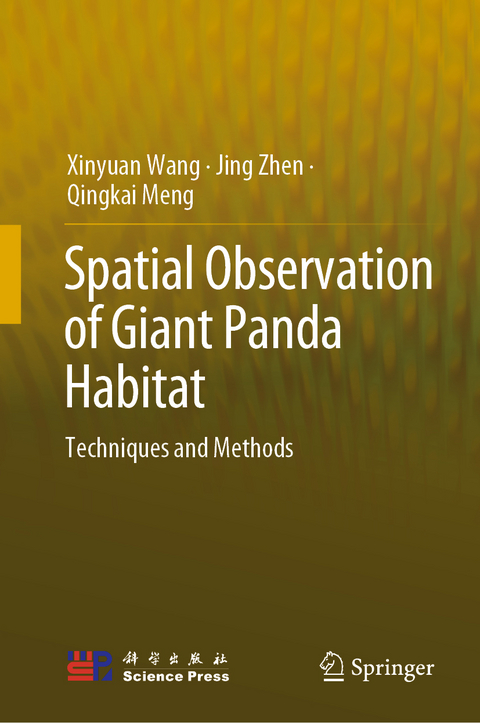
Spatial Observation of Giant Panda Habitat
Springer Verlag, Singapore
978-981-19-8793-9 (ISBN)
This book evaluates the past, present, and future habitat suitability of giant pandas based on spatial observation technology involving optical remote sensing, microwave remote sensing, and LiDAR to discover the mysterious ecological environment of giant panda habitat. Considering the problems faced by the world natural heritage site protection, it takes the world natural heritage site “Sichuan Giant Panda Sanctuaries – Wolong, Mt Siguniang and Jiajin Mountains” as the research area, exemplifies systematically the various techniques and methodologies of spatial information technology for monitoring, evaluation, and prediction of rare and endangered species habitats, and provides scientific suggestions for sustainable development of giant panda habitat based on a series of comprehensive case analysis at Wolong national nature reserve and Ya'an prefecture, Sichuan province, China. The book serves both as a textbook in the field of natural heritage protection, remote sensing, and GIS application, as well as a reference for managing natural heritage sites.
Dr. Xinyuan Wang is Professor at the Aerospace Information Research Institute(AIR), Chinese Academy of Sciences. He is also serving as Deputy Director of International Centre on Space Technologies for Natural and Cultural Heritage (HIST) under the Auspices of UNESCO, Chair of Digital Heritage Specialized Committee of China National Committee, International Society for Digital Earth (ISDE), Co-Chair of the Heritage Working Group of the Digital Belt and Road Programme (DBAR), Member of International Council on Monuments and Sites (ICOMOS), and Member of the world heritage Expert Committee of the State Forestry and Grass Administration of China. Prof. Wang is engaged in the research of remote sensing archeology and digital heritage conservation and application. He had published more than 180 papers and 5 books and published “Context Environment Map of World Cultural Heritage Sites along the Silk Road”. Dr. Jing Zhen is Associate Professor of the Aerospace Information Research Institute (AIR), Chinese Academy of Sciences. She was engaged in the research of remote sensing satellite data acquisition and remote sensing thematic information extraction for more than 20 years. She is also Key Member of International Centre on Space Technologies for Natural and Cultural Heritage (HIST) under the Auspices of UNESCO. Recently, she mainly focused on research of the evaluation and prediction of the impact of climate change on the habitat of giant panda. Based on multi-source remote sensing data and field verification, she has carried out fine-scale evaluation of giant panda habitats and countermeasures against the impacts of climate change. Relevant research results have been published in sustainability of MDPI and the monograph “Space Observation Techniques and Methods of Giant Panda Habitat” published by Science Press. At present, Dr. Zhen is looking forward to do cooperation research with friends all over the world on the impact of climate change and contribute to the monitoring, protection, and sustainable development of world heritage sites. Dr. Qingkai Meng is Professor at the Institute of Mountain Hazards and Environment (IMHE), Chinese Academy of Sciences. He is also serving as Associate Fellow of International Consortium on Landslides (ICL), Key Member of international network on landslide early warning systems (LandAware), and Member of European Geosciences Union(EGU). He was engaged in the research of landslide monitoring, recognition, early warning, and evaluation by interferometric SAR and multi-remote sensing analysis. He has carried out experiments of various landslide deformation mechanisms in giant panda world heritage sites, Loess Plateau, and Qinghai-Tibet Plateau. He had published more than 10 peer-reviewed papers with high impact index. At present, Dr. Meng is looking forward to do cooperation research with friends all over the world on the landslide science induced by climate change, especially in Qinghai-Tibet Plateau, and contributes to provide sustainable and consolidate monitoring strategy for risk mitigation and prevention.
Chapter 1. Natural heritage sites and space observation.- Chapter 2. Space monitoring technology and method of natural heritage sites.- Chapter 3. Technology and method of fine information extraction of animal habitat elements.- Chapter 4. Analysis of changes of key environmental parameters of land surface characteristics of giant panda habitat.- Chapter 5. Spatial observation and assessment of ecological environment change of giant panda habitat.- Chapter 6. The evaluation model of long-term monitoring and restoration of ecological environment by remote sensing after earthquake.- Chapter 7. Fine-Scale Evaluation of Giant Panda Habitats and Countermeasures against the Future Impacts of Climate Change.- Chapter 8. Suggestions for sustainable development of giant panda habitat.
| Erscheinungsdatum | 08.06.2023 |
|---|---|
| Zusatzinfo | 106 Illustrations, color; 61 Illustrations, black and white; XVII, 378 p. 167 illus., 106 illus. in color. |
| Verlagsort | Singapore |
| Sprache | englisch |
| Maße | 155 x 235 mm |
| Themenwelt | Naturwissenschaften ► Biologie ► Ökologie / Naturschutz |
| Naturwissenschaften ► Geowissenschaften ► Geografie / Kartografie | |
| ISBN-10 | 981-19-8793-9 / 9811987939 |
| ISBN-13 | 978-981-19-8793-9 / 9789811987939 |
| Zustand | Neuware |
| Haben Sie eine Frage zum Produkt? |
aus dem Bereich


